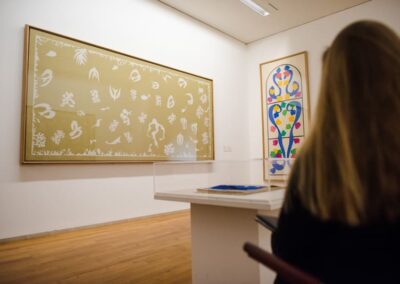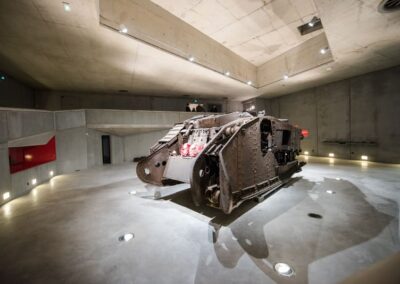Welcome to Cambrai
Nestled in the heart of the Hauts-de-France region, between Arras and Lille, the area around Cambrai is a treasure trove of history and culture that invites visitors on a memorable journey through time. For British visitors, Cambrai holds a special place in history due to the pivotal Battle of Cambrai in 1917, where tanks were used on a massive scale for the first time. Today, Deborah D51 stands as a living memory of this significant battle.
The Battle of Cambrai
Birthplace of Matisse
Wilfred Owen

Stunning heritage
Sweet treats
A journey through art and history
Cambrai is celebrated for its delightful “Bêtises de Cambrai” mint candies and traditional andouillette sausages, offering a true taste of the region’s culinary heritage. Art enthusiasts will find themselves drawn to the impressive Matisse Museum in nearby Le Cateau-Cambrésis, the birthplace of Henri Matisse. This museum, home to one of the largest collections of Matisse’s works in France, provides an inspiring exploration of his artistic journey, making it a must-visit for anyone passionate about art.
Explore Architectural and Cultural Marvels
The city’s rich heritage is evident in its stunning architecture. Begin your exploration at the town hall, a 19th-century classical style building adorned with a decorative clock tower. Don’t miss the majestic Cambrai Cathedral, rebuilt in the 17th century, and the Church of Saint-Géry, home to Rubens’ masterpiece “La Mise au Tombeau.” The Chapel of the Jesuits, with its ornate baroque facade, is another gem worth visiting. As a designated City of Art and History, Cambrai also boasts an impressive collection of Art Deco buildings, adding to its phenomenal architectural heritage.

DEBORAH NOW STANDS IN TESTIMONY TO THE CRUELTY AND HARSHNESS OF THE FIGHTING. THIS BROKEN IRON MONSTER IS THE UNFORGETTABLE CENTREPIECE OF THE CAMBRAI TANK 1917.
Cambrai during WW1
On November 20, 1917, at 6:20 am, 476 British Mark IV tanks launched an assault on the Hindenburg Line. This is the start of the Battle of Cambrai, an offensive designed to breach this ‘impregnable’ German fortified defence line. At dawn, the silence is broken by the sound of engines and the clatter of tank tracks moving across the chalky soil. In thick fog, the advance of these new machines of war was initially masked by the drone of patrolling planes and the tumultuous roar of the massed artillery. Planned for months, in the greatest secrecy, the offensive heralds the birth of tank warfare; tactics that will influence Hitler’s Blitzkrieg and dominate the next century of warfare. Deborah, a ‘female’ tank, was one of the 476. Discovered in 1998, when she was unearthed from the battlefield, where she lay 2.5 metres underground.
Tragic fates of the Great War

The tank crew of Deborah
The Battle of Cambrai

Wilfred Owen
November 4th, 1918

William Malcolm Chisholm
First Australian to die in WW1, Ligny-en-Cambrésis
Unmissable spots
Musée Matisse
Lace museum, Caudry
Cambrai Tank 1917
Prepare your visit
Explore together
Tailor made group tours
Discover the magic of Cambrai with our tailor-made group tours, providing you with the reassurance of a personalized experience that caters to your interests and preferences. Let our team of experts guide you through this historic city, ensuring that every moment is filled with wonder and discovery. Join us on a journey unlike any other as we explore the hidden gems and remarkable stories that make Cambrai a truly unforgettable destination.
Before your visit: Frequently Asked Questions
What are the key historical sites related to the Battle of Cambrai?
Visitors often inquire about the significant sites related to the Battle of Cambrai. Key locations include the Cambrai Tank 1917 Museum, based in the nearby village of Flesquières, and the Flesquières Hill British Cemetery, where four crew members of Deborah rest in peace just by the museum. Additionally, various memorials and battlefields, such as the Monument of Nations and the site of Deborah D51’s discovery, are significant points of interest. The Cambrai Memorial commemorates more than 7,000 servicemen from Britain and South Africa who died in the Battle of Cambrai and whose graves are not known. The names of the fallen are inscribed inside the Memorial. Located next to Louverval Military Cemetery, in Doignies, where the remains of 124 British soldiers rest, the Cambrai Memorial pays tribute to these 7,048 combatants from the United Kingdom and beyond.You can also visit the Wilfred Owen Forest House, dedicated to the poet of the Great War, located in the village of Ors, where the poet is buried in the communal cemetery.
What is the best way to travel to Cambrai from the UK?
Many visitors want to know the most convenient travel options. The most common option remains traveling by car (or campervan or camping car). Cambrai is within easy reach from the port of Calais. You can travel by ferry from Dover to Calais or take the Eurotunnel from Folkestone to Calais. It will take you about a 1.5-hour drive from there. Please be aware that the A26 motorway towards Reims has tolls.
Eurostar services to Lille also provide a direct route from London, followed by a local train to Cambrai. The Eurostar terminal in Lille is Gare Lille Europe, and you will take a local train to Cambrai from Gare Lille Flandre, which is within walking distance of about 500 metres. Alternatively, you can fly into nearby airports such as Brussels or Paris and then take a train or rent a car.
Are there guided tours available for the Battle of Cambrai sites?
Cambrai offers a variety of attractions beyond its war history. Visitors can explore the Matisse Museum, taste local delicacies like “Bêtises de Cambrai,” and visit architectural marvels such as the Cambrai Cathedral and the Church of Saint-Gery. Alternatively, dedicated group tours are organised.
What other attractions are there in Cambrai besides the battle sites?
Cambrai offers a variety of attractions beyond its war history. Visitors can explore the Matisse Museum, a must-see for art enthusiasts, taste local delicacies like “Bêtises de Cambrai,” and visit architectural marvels such as the Cambrai Cathedral and the Church of Saint-Gery. A visit to the Dentelle de Caudry Museum, dedicated to the world-famous fashion and lace industry, is highly recommended. The Vaucelles Abbey, nestled in a charming valley, is also worth a detour.
Additionally, Cambrai, located in the north of France, has a long tradition in brewing. As British visitors, you will certainly enjoy our distinctive brews, reflecting our close links to Belgium that are still alive today.
What local delicacies should I try in Cambrai?
Food enthusiasts often ask about the local cuisine, and Cambrai has much to offer. There are many excellent restaurants in Cambrai, and we provide a selection in our “Prepare Your Stay” section. In Cambrai, you should definitely try the “Bêtises de Cambrai” mint candies. Andouillette sausages, often served grilled with chips and a delicious Maroilles cheese sauce, are a local specialty.
Please note that andouillette might not always suit British tastes, as it is sometimes described as “awful,” but let’s be realistic—every culture has its unique dishes. For example, you have haggis or marmite in your diet!
The region is also known for its brasseries and local beers, which reflect the area’s rich brewing tradition.The beer will surely delight everyone, whether French or British, and bring everyone to agreement.
Are there family-friendly activities in Cambrai?
Yes, Cambrai offers several family-friendly activities, including the public gardens, local parks, and the engaging historical exhibits at the Cambrai Tank 1917 Museum. The museum provides interactive displays that are suitable for all ages.
What accommodation options are available in Cambrai?
Visitors often seek recommendations for places to stay. We have designed a dedicated section with recommendations for Bed & Breakfasts and hotels that we believe would suit British tastes. From 2 to 3-star hotels to charming B&Bs, there are plenty of options to choose from. Additionally, British visitors often come by campervan, and the camping site in Cambrai welcomes many of your fellow travelers. It’s recommended to book in advance, of course.
What events are held in Cambrai throughout the year?
Cambrai hosts several cultural and historical events throughout the year. Visitors should check local tourism websites for up-to-date information on festivals, commemorative events, and other cultural activities on the French website for the Cambrai Tourist Office. The major festival in Cambrai is held on August 15th, featuring the giant procession of Martin and Martine and a massive fun park.
Is it easy to get around Cambrai without a car?
Cambrai is a walkable city with many attractions located within a short distance of each other. Public transportation and taxi services are also available for getting around. Please note that there are no underground or tramway services, but there is a bus network. If you want to visit World War I sites, you will need a car as the memorial sites are located around Cambrai and spread out in the neighboring villages. Renting a bicycle can also be a fun way to explore the city and its surroundings.












































